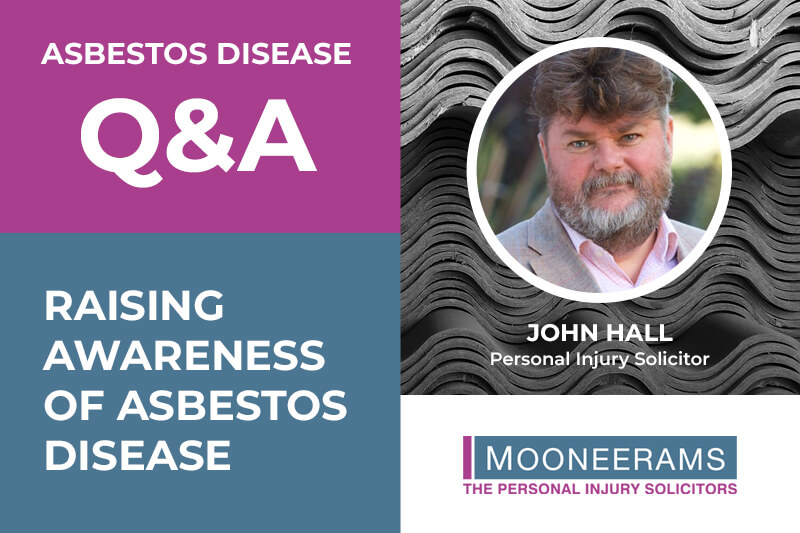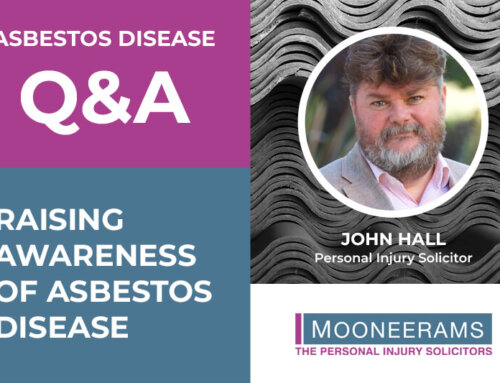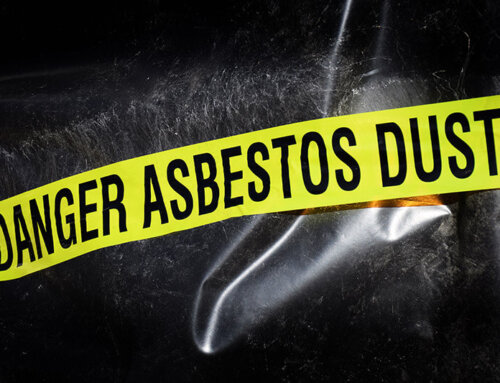Over the next six weeks, we are publishing a series of articles offering expert advice around asbestos disease.
In this Asbestos Disease Q&A: Part One, we discuss being a specialist asbestos disease lawyer; introduce the five main types of asbestos disease; detail what Pleural Plaques are and what Pleural Thickening is.
A few weeks ago, we sat down with one of the most experienced asbestos disease solicitors in the UK, John Hall, to ask him all about asbestos disease; how people get exposed to asbestos, and the process involved in making a successful asbestos disease claim. We think this collection of blogs is unique in that it consists entirely of questions and answers that were asked and answered in depth by one of the foremost asbestos disease claims experts in the country.
John Hall is described in The Legal 500 as having a ‘track record of work on complex asbestos disease claims’. John is the solicitor who will handle your asbestos disease compensation claim should you decide to ask Mooneerams to handle your claim.
During October and November we are running an asbestos awareness campaign to help people understand more about asbestos disease, a group of illnesses for which there is no cure, and which can take up to 50 years to develop. In this first blog, John tells us a little bit about himself and asbestos work and then goes on to talk about the first two of five main types of asbestos conditions – pleural plaques and pleural thickening.
Thanks for talking to us John. Could you first of all tell us a bit about yourself and how you came to specialise in asbestos disease claims?
Thank you for asking me.

I was formerly a partner with a large trade union firm and have many years’ experience of dealing with all types of asbestos cases including, claims against employers and occupiers, and environmental claims against asbestos companies. However, the overwhelming majority of what I now do, is asbestos work on behalf of clients relating to occupational exposure anywhere between 1950 and 1990.
I’ve got a proven track record, recovering between one and two million pounds on behalf of clients every year. I am completely committed to asbestos disease work and helping my clients. I don’t take a percentage of my clients damages (compensation) at the end of the claim, and I only ever act for claimants, never for defendants.
Without wanting to sound pompous, I believe I have become very good at what I do. My being an asbestos expert is important to my clients chances of pursuing successful cases. Asbestos disease claims are not straightforward matters, and it really benefits them to have a solicitor who knows this complex area of law, inside and out.
Could you explain the difference between the different types of asbestos disease, as many people are under the false impression that there is one asbestos disease and that it is called asbestosis?
There are five main asbestos diseases. The first one is called pleural plaques, for which you are no longer able to claim compensation, In England and Wales. That has been the position ever since the decision in a case called Johnston v NEI International which went all the way to the House of Lords in 2007.
It is still possible to make a pleural plaques claim in Scotland, which has it’s own legal system. We can’t take on Scottish claims however, given the difference in legal jurisdictions.
Pleural plaques are scarring on the outside surface of the lungs and will show up on a chest x-ray as calcified white dots or sometimes as a shadow on the lungs.
Pleural plaques won’t cause any disability and won’t affect the functioning of the lungs and that was why the court decided in the Johnston case, that if you’ve got pleural plaques, you’ve not been injured. Interestingly the court decided that pleural plaques had never been compensatable in England and Wales. This is an important legal ruling because it means that if you get pleural plaques and then go on to get another asbestos disease at a later stage, you are not prevented from claiming for the later illness.
What is the second type of asbestos disease you want to tell us about?
The second type of asbestos disease and one we can help victims of the condition to claim compensation for, is pleural thickening, which is scarring on the underside of the lungs, most particularly in the lung bases.
Often this will be associated with pleural scarring and there will be some folding of the lung. If you see evidence of folding in a scan or x-ray, it’s a classical sign of pleural thickening and it will cause disability as the lung is restricted.
A person with pleural thickening will have difficulty breathing in and out. All asbestos diseases tend to be restrictive. Compare this with obstructive diseases, like COPD (Chronic Obstructive Pulmonary Disorder), which affects the ‘breathing tubes’, the bronchia.
Quite often I am contacted by people who have both COPD (usually as a result of smoking) and pleural thickening, which together cause severe restrictions on the person’s breathing. However, you can only be compensated for the effect of the asbestos disease, i.e., the pleural thickening, not for the COPD caused by smoking.
Pleural thickening does tend to progress, meaning the condition can get worse over time. All these conditions are untreatable. This is the reason asbestos disease victims should pursue asbestos compensation; they’ve got a breathing deficit and it is only likely to get worse. Had they not been exposed to asbestos by their employers, they would never have been put into the position they find themselves in, in later life.
The fact that someone has been exposed to asbestos means that even if they are diagnosed with an asbestos disease, there is still the possibility they’ll go on to get another asbestos disease, as time moves on. When settling an asbestos disease claim, I always try to make sure that the compensation takes into account the risk of my client getting another, possibly more serious, asbestos disease as time moves on.
In the second Asbestos Q&A blog of the series, John Hall will answer questions about asbestosis. In the meantime, should you receive a diagnosis of asbestos disease or even if you are worried you may have the symptoms of asbestos disease but have not yet been to see your GP, call Mooneerams on 029 2048 3615 and we’ll get John to call you back for a no-obligation chat about your situation.




